WEST VIC REGION


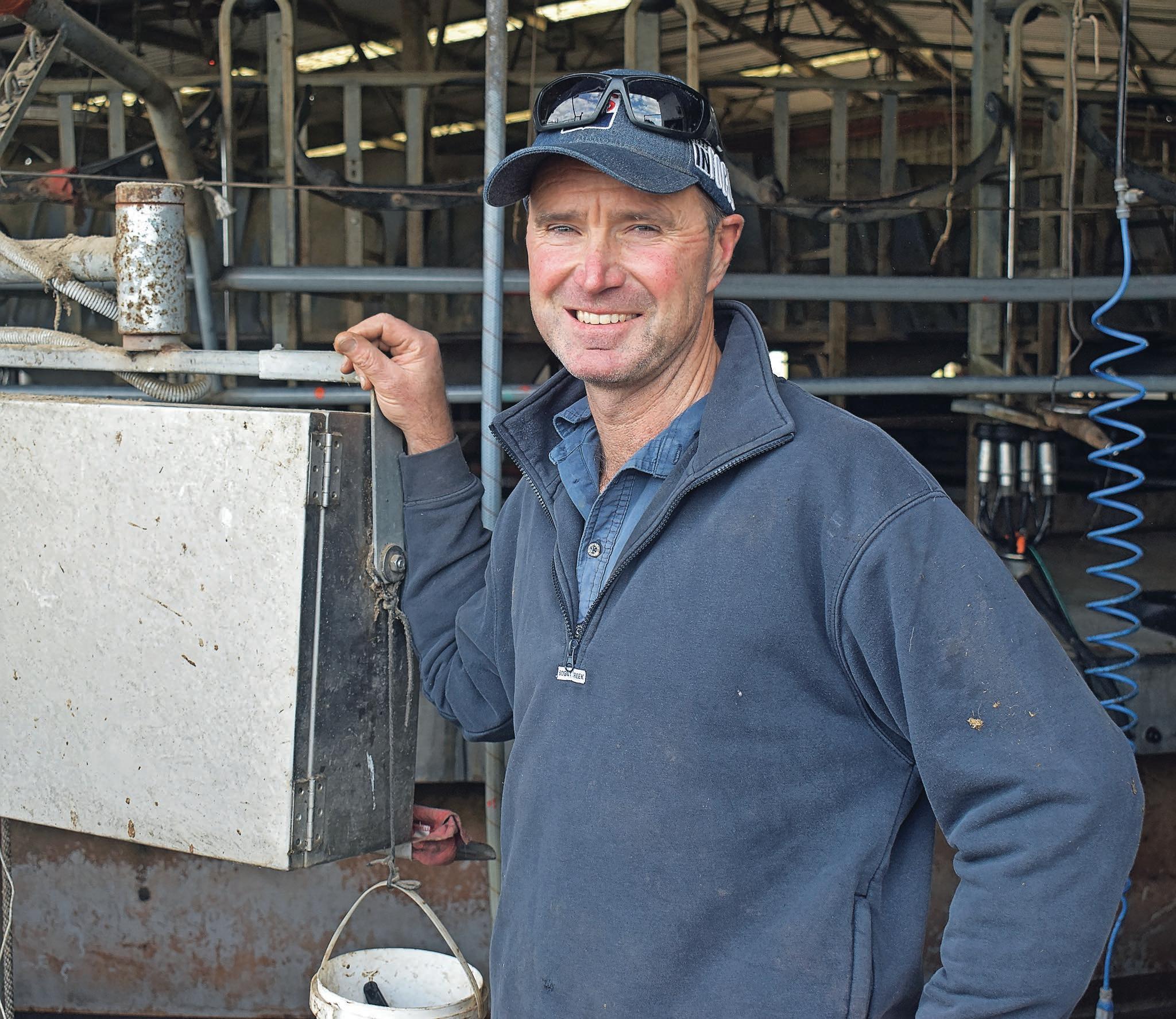





Simon Rea sees Australian dairy becoming more intensive in the future, and he’s ready for it. Page 7.


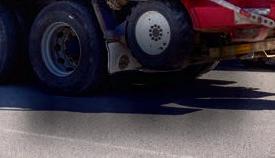



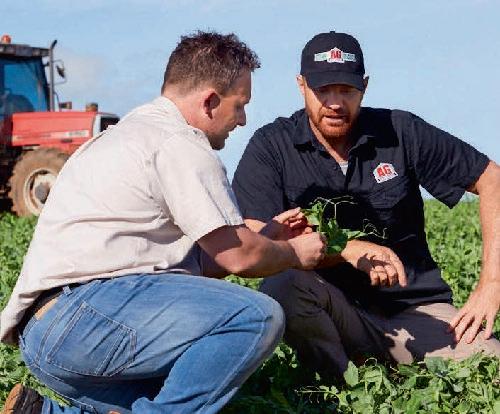






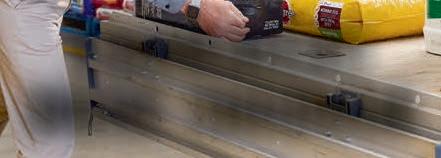


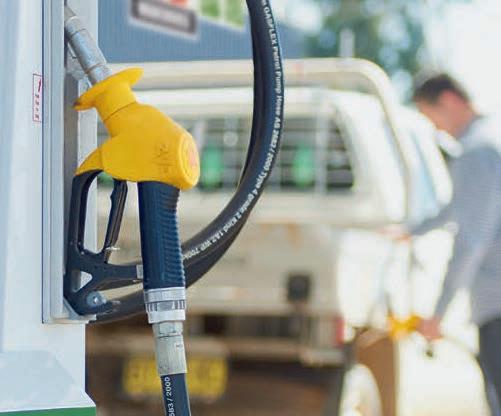



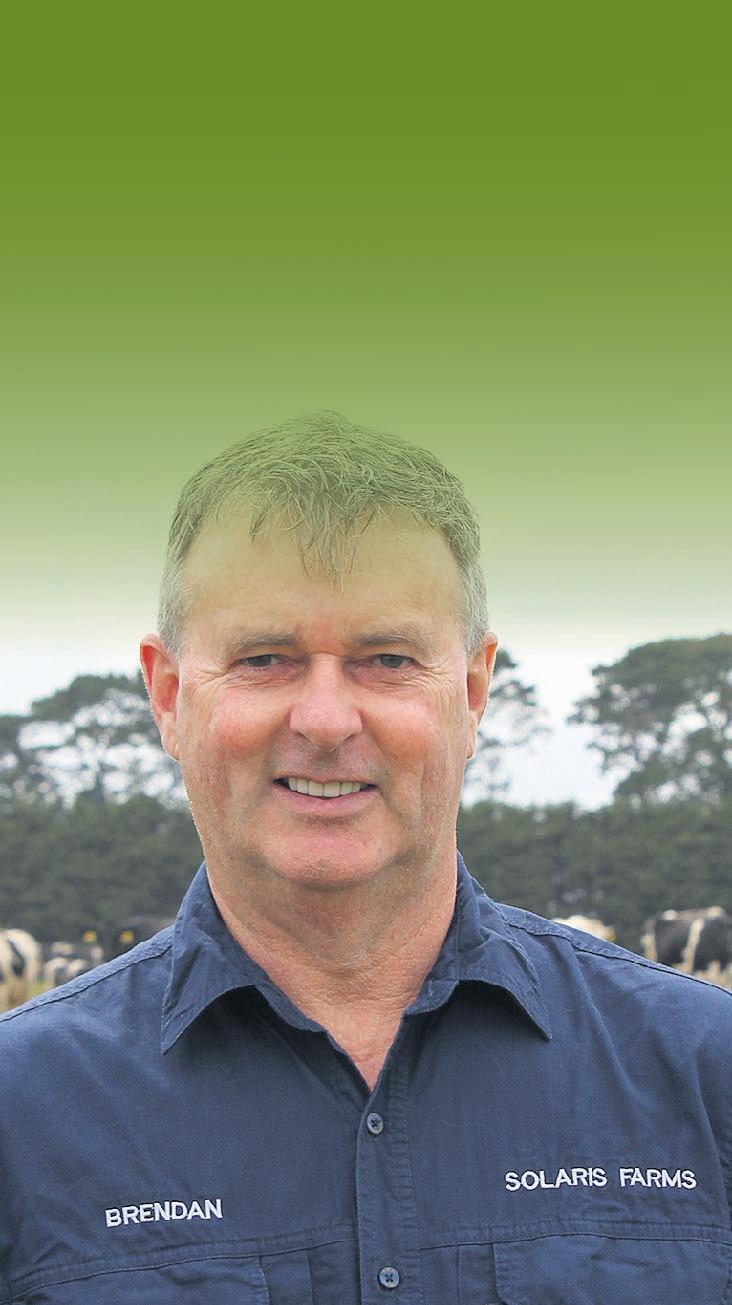




BY BRENDAN REA
THE WESTVIC Dairy team has been out on the road since late May, visiting farmers oneon-one to deliver drought support packages, to listen to what they need and to help where they can.
Many dairy farmers are feeling nervous about the possibility of a failed spring, yet also hopeful. A bit of warmth and decent rainfall could help kick-start farming back into some sense of normality.
I’m focused on making the most of spring. It’s our key window for annual growth and silage production.
This year, my approach to spring will look quite different on the farm because of the poor pasture conditions caused by the drought.
For the first time ever, I had to re-sow the entire farm in autumn. Unfortunately, much of it germinated too late, and the limited rain we’ve had has quickly turned paddocks boggy.
Despite applying seed and fertiliser, we’ve seen no winter growth. Since September 2023, we’ve had only about two-and-a-half months of effective growing conditions.
Even with a good spring, silage yields will likely be lower, and pastures will lag in tillering. Farmers across south-west Victoria are facing the same or similar challenges.
WestVic Dairy is here to help farmers plan

The WestVic Dairy Board plays a pivotal role in supporting and advancing the dairy industry in our region. There are three farmer positions, and a specialist (non-farmer) position available. These director positions o er the opportunity to give back to the dairy industry while enhancing your leadership capabilities. If you are up for the challenge of this fulfilling role, we invite you to apply by Thursday 14 August 2025.
for spring 2025 and make the most of their resources.
In response to farmer feedback, WestVic Dairy will be running three Maximising Spring workshops across the region in August. Respected farm consultants David Wisewould and Phil Shannon will lead these sessions.
I’ll be attending the session closest to me. These current conditions and lack of pasture on farm is something I’ve not experienced before, and I’m keen to learn and hear their insights.
The workshops will go into detail about: maximising production and utilisation of home-grown feed and fodder, summer cropping options (especially for resown paddocks that have failed), fertiliser strategies, pest and grazing management.
Dairy Australia also offers a range of drought-specific webinars and resources to support your spring setup.
To explore these tools and register for a Maximising Spring session near you visit: westvicdairy.com.au
Whatever the season brings, the actions we take now can pay off when conditions improve.
WestVic Dairy is committed to supporting farmers where it matters most.
A big part of this is our experienced local board of dairy farmers and service providers who guide the organisation’s strategic direction. Their local knowledge ensures we
stay focused on what matters to our dairy community.
We’re currently inviting applications for director positions for both farmer and specialist (service provider) roles. If you’ve ever considered joining the board but weren’t sure, I encourage you to apply.
We offer comprehensive training in business management and corporate governance, and you’ll be joining a team that works well together and has strong industry connections. You’ll be mentored and surrounded by experienced farmers and agribusiness professionals who are passionate about the dairy industry.
You learn just as much from other board members as you do from formal training.
What you learn on the board can benefit your own personal development, your business and your community.
We welcome passionate individuals with fresh ideas and a collaborative mindset who want to see the south-west dairy industry thrive.
Visit westvicdairy.com.au to learn more and apply. Applications close on Thursday, August 15.
And finally, remember to look after yourself, your staff and your family. It’s okay not to be okay, please reach out if you need a hand. There are people and communities thinking of you and ready to help. Let’s continue to support each other.
– Brendan Rea is the WestVic Dairy chair.
BY RICK BAYNE
JAMIE VOGELS nominated for Corangamite Shire Council in 2020 because he wanted to have a farmer’s voice at the council table.
Little did he know how important that input was going to be.
Jamie farms with his brother Andrew at Scott’s Creek, and in 2023 was on the front foot highlighting the impacts of timber plantations in the prime dairying region.
In 2025, he’s pushing for greater support for drought-afflicted farmers and to fight increased government tax burdens.
While there are now four councillors with farming connections, Jamie said you could never do too much to highlight the importance of agriculture in Corangamite Shire, Australia’s richest milk-producing local government area.
An electrician by trade, third-generation farmer Jamie has been home on the farm for 30 years, but he’s never experienced anything like this season.
He and Andrew and four staff manage more than 600 hectares and were milking 750 cows before the drought.
“This year we’ve destocked about 100 cows because we’re worried about water and the high cost of feed and the relatively low price of milk,” Jamie said.
Not only have they had to cut numbers, they’ve spent an extra $500,000 on imported feed.
“The previous two years we probably had 1000 rolls of silage left over each year as a buffer,” Jamie said.
“Last year through the drought, we fed all that and bought two loads of feed — which was the first time we’d had to buy hay for a long time. This year we’ve spent an extra half a million on feed.”
As well-established farmers, they can borrow on equity, but that has long-term implications.
“You try to build up your equity for the big-ticket items,” Jamie said.
“Our dairy is 32 years old, but we’ll have to push a new one down the track a bit further.
“The drought is increasingly taxing and the government is taxing increasingly,” he said.
“That is one of our biggest issues because we came into this year below cost of production and then we have extra taxes on top of that.
“You pull back on maintenance and infrastructure; you just try to survive.
“It’s thrown the industry into massive turmoil because we don’t have the capacity to cope, because, in a great part of the government increasing taxes and levies are driving input costs to record highs.
“Every tax and levy that goes on anyone in the community, you either suck it up or pass it on. It means we have to pay more for services and supplies.
“Energy costs have gone up again, also driving up direct input cost, but we have to compete on the world market.
“Big commercial businesses need to take a good hard look at themselves as they are already getting their cheese from New Zealand and America.
“Most people will buy Australian if they can, but if it’s tough and an import is cheaper, for some they may have no other choice.
“We’re not living the dream driving around in Mercedes here. We’re just trying to create food and get enough money to keep up with technology, which I’m way behind on, and comply with increasing regulations.”
Jamie mixes his farm and shire work.
“I’m still here on the farm every day,” he said.
“If we’ve got a council meeting, I’ll feed the cows and calves in the morning before heading off and leaving it to the staff. Those days I
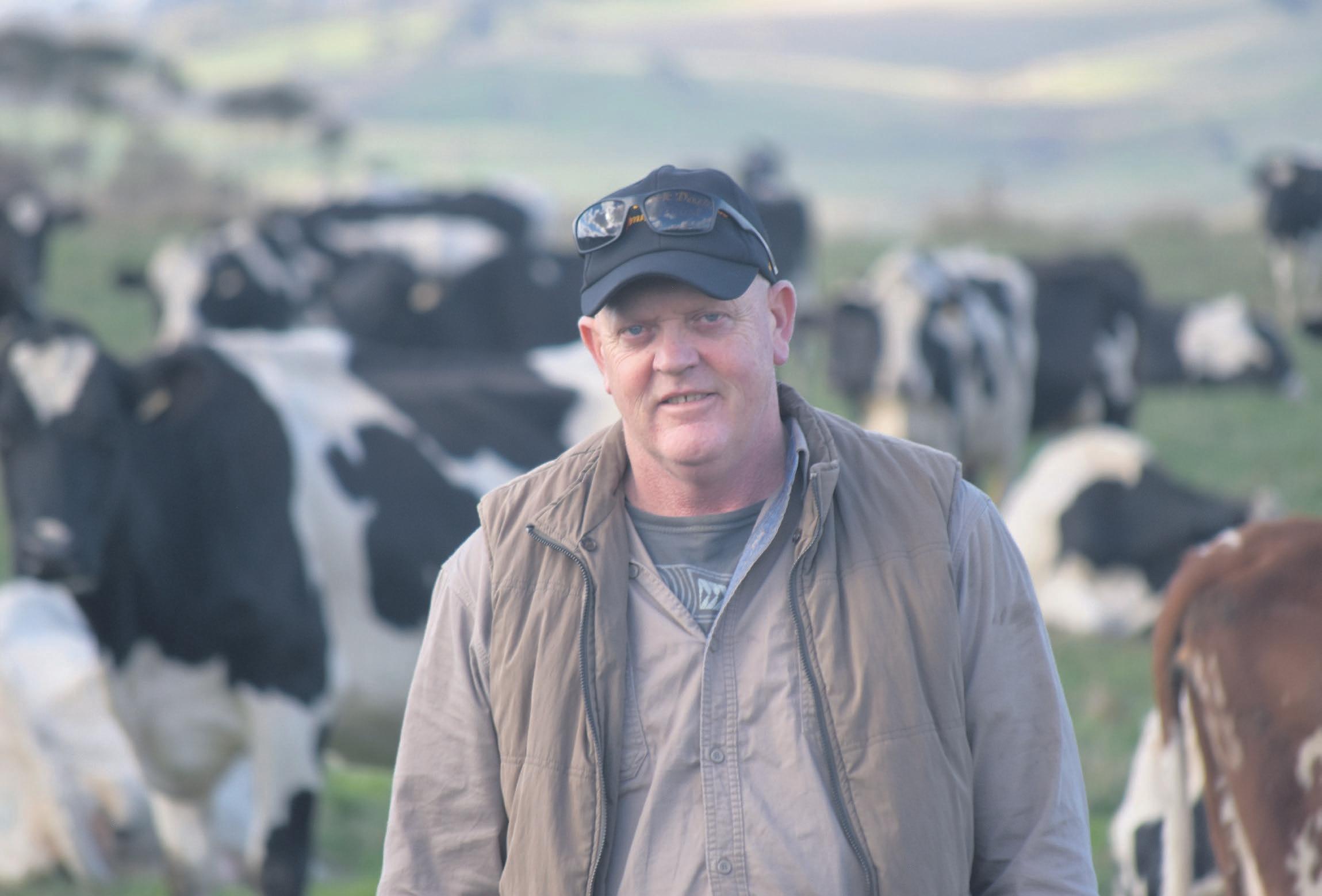

probably put in four or five hours, as opposed to the usual 12.”
He said the current challenges were not anything new for farmers.
“Ever since I’ve been on the farm, there has been a lot of pressure,” he said.
“You have a few good years and try to catch up with infrastructure upgrades, technology and maintenance, and then you have another setback.
“I think it’s important to remind people that around here agriculture is king and provides the base for the economy.
“My natural state is to stay out of the limelight, but there are times you need to step up.
“Everyone is suffering through this and I’m here to represent my community.”
This year Corangamite Shire has allocated $500,000 to drought support and Jamie said if state and federal governments committed the same percentage of their budgets to drought support, the pressures would be eased.
The shire started pushing for more drought support in August 2024 and has been advocating for a water strategy for many years.
“They’ve come out with a relief package, but it’s definitely reactive – the horse has bolted.
“If we get another year of drought, the bank might come a knocking on a lot of people.”
A push to develop more timber plantations in Corangamite remains a big issue, with a processing company willing to spend $200 million to purchase land in south-west Victoria, targeting the former Heytesbury Settlement region.

“That would get them about 10,000 hectares, and my understanding is that they’re 3500ha into that,” Jamie said.
“You can see a massive difference in the area just from that.
“Agriculture contributes 100 times more than forestry to the shire economy including 45 per cent of the economic output, 38 per cent of the jobs and 70 per cent of the exports.
“Our towns and communities rely heavily on farming with most of the 2400 plus jobs and $60 million in wages annually coming from dairy, meat production, sheep and cropping and agricultural services.
“Dairy turns over $6000 a hectare per year and has a multiplier effect for the economy.
“You take that out of the economy and probably one job every 100ha and you lose families, volunteers.”
While he said the shire was hamstrung because it’s approved federally through the Foreign Review Investment Board, it wants to highlight the importance of protecting prime agricultural land.
“We’ve asked for a planning review with a proposal to require a planning permit for land change for the trees, but that’s still sitting on the minister’s desk. It will be a long drawn-out process.”
Jamie said despite the frustrations, he still loved farming.
“You couldn’t do it if you didn’t enjoy it.”

BY RICK BAYNE
YOU COULD say that Michael Beecher has moved from the pot to the frying pan.
Michael sold his farm near Shepparton to avoid northern Victorian droughts and moved to south-west Victoria in August 2023.
Returning to the region where he grew up seemed like a perfect fit, but little did he realise he would be moving into the worst drought in memory.
Coupled with a big drop in milk price and a lull in his excavation business, Michael and his wife Katie and their three children have endured a heartbreaking transition.
“For the last six months, I’ve just traded my time for bills,” he said.
“You’re working 90 hours a week and getting nowhere. When things start breaking, you can’t afford to fix them. It’s stressful to be honest.”
Despite all the challenges, Michael manages to keep a smile on his face, and things are starting to turn.
“Rewind two months ago, we didn’t know what was going to happen, but now there’s some light at the end of the tunnel,” he said.
The new season milk price has recovered most of the ground lost last year, and his excavation business has a new contract starting in October.
“It was just bad timing for us, with a mixture of things happening all at once. If we get through this, I reckon we can get through anything,” Michael said.
A plumber by trade, Michael got into civil construction and started an excavation business in 2018 when their first child was on the way.
He grew up on his parents’ dairy farm just minutes from his current property on the edge of the Otways National Park at Cooriemungle.
“Dad got out during deregulation in 2001 and we moved to Ballarat when I was 13 or 14, but I was very hands-on and was hosing the yard out before school,” he said.
“I loved it, breathed it, and always wanted to be a dairy farmer.”
With the excavation business humming along nicely, Michael decided to pursue his first love — dairy farming.
“I realised I was never home, travelling up to two hours each way and 10-12 hours on site.
“I probably work longer hours now, but I’m at home, and that means a lot,” he said.
The family had planned to use excavation business profits to fast-track their dairy plans.
“It was extra security; that was my base and the dairy farm was on the side,” Michael said.
They tried to buy a farm in south-west Victoria, but were put off by high prices, so instead invested in a “renovator’s delight” at Invergordon, near Shepparton.
“It was a good farm but a steep learning curve,” Michael said.
“We had to get the paddocks and pasture up to scratch, new fencing, fix the dairy and irrigation, but we got it up to an operational state within a year and a bit.”
It was going okay, but Michael wanted climate security.
“Everyone talks about the drought up there, so I thought we needed to get out.”
With support from his father Graham, Michael inspected several potential properties before deciding on his Cooriemungle farm.
“This was a dream showcase farm,” he said.
“It has good sheds, a good dairy, a good house and everything was ready to go, but it also came with a big price.
“I went out on a limb and took on a lot of debt, but the milk price was good and the excavation business going okay.”
The first few months were smooth sailing,

but soon things went “pear-shaped”.
Melbourne’s construction industry went into a downturn, and the farm had to fund the excavation business while waiting for contract payments — the opposite of what they were expecting.
“The excavation work fell in a heap and we sold the machines at auction for less than half price and then the milk price went from $9.40 to $8.10 — which was about a $400,000 pay cut,” Michael said.
“Combined with the excavation business closing up, it’s about $2 million down in income. Our debt levels are too high to operate the farm on its own — I wouldn’t have bought the farm without the excavation business.
“Both combined was a big hit for us. We could work through it, but then we had the dry summer and autumn, and now we’re in a
situation where we’re just scraping through.”
They brought about 250 cows from northern Victoria, but needed to be around 350 to 400 to service debt so had to buy more, resulting in more debt.
“We thought we were doing the right thing to maximise production,” Michael said.
“We didn’t factor the milk price dropping as much as it did, or the excavation business going into a downturn, and then the drought — it’s all external stuff.”
They are paying 10 per cent on the farm loan after seeking bridging finance from a non-mainstream bank when the northern Victoria sale was delayed, and also have to repay a loan on the cows.
Looking at the big picture, Michael sees the high interest rate is a big contributor to their difficult position.
On the bright side, the milk price being paid by his processor ACM went back up to $9.35 and an early July step-up took it to $9.45, there’s a new contract that will see the excavation business resume in October and the drought hasn’t impacted as badly as some.
“The big dam was completely empty. The previous owners were here for 35 years and that never happened to them, that’s how dry the season has been,” Michael said.
“We had to pump water to get through, but we’re lucky compared to some with the drought. I sowed a lot of annual rye grasses, aiming for early feed, and we’ve been grazing now for six weeks.”
They had hit the sweet spot of 360 to 370 cows, but are now down to about 250.
“We kept our productive fresh cows fed well and they have been milking terrific, about 2.3 kg/MS per cow.
“It wasn’t viable to keep any carry-over cows so we had to sell some to release funds to buy hay.
“It worked out because we couldn’t ask any more of the cows we’re milking, but it’s going to be a long road to build up again.”
Michael and Katie do as much work as possible while raising three children, but two backpackers help, and they hope to appoint a farm manager to allow Michael to get the excavation business back up and running with a new water mains crew.
They also sought help from ACM field officer Lionel Clayton and Geroge Leishman from Rural Financial Counselling and consultants who have helped them through the tough times, and have benefitted from industry generosity.
“We registered with Aussie Hay Runners and got a semi load of hay,” Michael said.
“It was enough to keep the young stock going for a bit longer. It was unbelievable timing. It
really saved us because we don’t have any fodder on the farm.”
Farming remains Michael’s first love — but he never wants to endure another year like this.
Katie, originally from Geelong, has grown to love the farm life, as do their children.
“The financial stress we’ve had this year has taken a toll on me mentally and on my wife,” he said.
But he’s going to see it through.
“When I was 30, we were just renting a house and had nothing to our names, so we’ve fasttracked the system over the past seven years,” he said.
“We really enjoy the job and you couldn’t get a better lifestyle.”

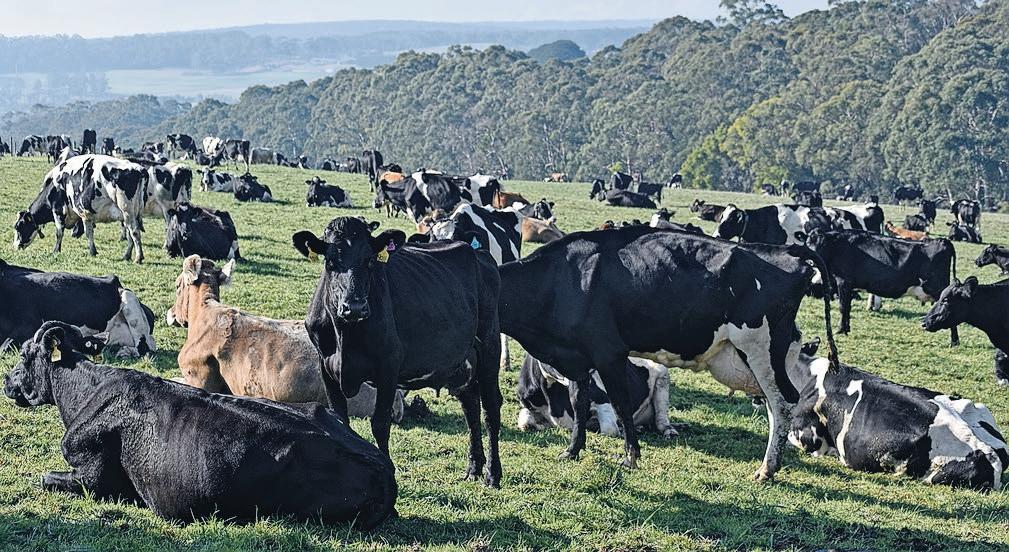


BY RICK BAYNE
KANGAROOS AND deer are causing huge problems for farmers in south-west Victoria’s Heytesbury region — and they fear the worst is yet to come. The animals are breeding in blue gum plantations and then crossing over to farmland, damaging fences and pastures.
Michael Beecher’s farm borders the Great Otway National Park at Cooriemungle.
The connection has some pros — the trees provide shelter for cows on the windy days that lash the area — but the cons are outweighing the benefits.
“There are a lot of kangaroos and deer that ruin fences and there’s an accumulation of pasture that they eat,” Michael said.
“I had intended to strip graze paddocks, but you go through and see what they’ve done and have to give the cows the whole lot.
“It’s costing us thousands.”
The farm is separated from the national park by a normal fence.
“We can’t afford to put up a kangaroo fence,” Michael said.
“We have other pressing priorities at the moment.”
Michael, who moved from near Shepparton with his family in August 2023, recently found another drawback when his car crashed into a kangaroo. Kangaroos and deer regularly cross the dirt road that leads to the farm.
“As more plantations go into the area, these incidents with kangaroos are going to become more and more common,” he said.
“It will get worse and will be an issue for a lot of people.”
About 30 kilometres away at Scotts Creek, Jamie Vogels is facing similar problems with the local kangaroo population more than doubling in recent years since the addition of a nearby timber plantation.

“We’ve got a massive problem with kangaroos,” he said.
“We’ve got hundreds and hundreds of them. They wreck all the fences, and you can imagine what 400 or 500 kangaroos will eat.”
On top of that, an explosion in the deer population is causing problems on the farm’s native vegetation.
“The deer ring-bark the trees,” Jamie said.
“I’m not sure if they rub on them or chew on them, but they’re making a hell of a dent.”
The farm has nearly 100 hectares of native bush and remnant vegetation.
“We had about 200 kangaroos with the native bush which was fine, but when the blue gums move next door and you’ve got 400 to 500 kangaroos grazing, you’ve got a problem.
“There’s nothing to eat there and then they move out on neighbouring farms to graze.
“All the feral animals from the blue gums next door moved over to our place.”
As a Corangamite Shire councillor, Jamie has
LINDSAY FERGUSON will retire at the end of July after nearly 10 years of dedicated service to the south-west Victorian dairy industry.
Lindsay is regional manager for Dairy Australia and executive officer to the WestVic Dairy Board, joining the team in early 2016 after many years managing teams in agricultural education and training at college and universities; in state and regional development; and in food sector investment and trade.
Along with board experience, the role was a perfect fit, combining all his areas of expertise.
“Over my time in the agricultural industry I’d seen WestVic Dairy commence and develop as I worked alongside it,” Lindsay said.
“In short, having respect for its vision, I thought I could help make a difference in the industry in the south-west through extension.”
Throughout his time at WestVic Dairy, Lindsay has supported the dairy industry and dairy farmers through numerous challenges.
“We had the price downturn and clawback in 2016; bushfires and dry seasons in 2018; COVID in 2020 and for the last two years, the worst drought on record,” he said.
“Overcoming all these challenges required great flexibility in our service delivery plans.
“We needed to keep well informed on the situation and collaborate with the rest of industry.
“Getting through these things as well as we did was only through the guidance of the board, the support of Dairy Australia and the hard work and dedication of our team.”
There were also some memorable moments.
“There have been some quite dramatic
moments during different crises over the years,” Lindsay said.
“But that aside, random things happen, such as fielding a phone call from Peter Russell-Clarke who had another idea for dairy industry promotion or when two federal government ministers dropped in on our AGM and it wasn’t even an election year!
“Our Dairy Awards is a standout event that encapsulates what we do: in recognising best practise and rewarding it while having some entertainment, a meal and some great networking with the farming community.”
Lindsay considers putting together and leading a strong team of highly competent professionals that deliver extension services to the south-west, one of his greatest accomplishments.
“In 2016, Dairy Australia chose to invest in more extension staff in the regions.
“With an exceptionally good team, who all have the best interests of the farming community as their goal, I believe that we have been able to really accomplish good things in this region.
“Since then, our team has matured and grown in number — doing great work in all areas. It’s a pleasure to work with motivated people who are keen to make a difference.”
He is proud of the tangible impact of the organisation on dairy farms.
“It’s a privilege being close to the farmers we deal with and seeing how they adapt their businesses to changing circumstances.
“It’s rewarding to see them learn about and implement practices that we have shared with them.”

Dairy Australia’s south-west Victoria regional manager Lindsay Ferguson is retiring.
What Lindsay will miss most is the people.
“I’ll miss being part of a great team — not just the staff and board at WestVic Dairy, but also the wider DA team and the even wider team we have of people and organisations that service the regional industry.
“I will miss seeing individuals in these teams play their part as we progress an idea through to a concrete program or event, promote and run it,
pushed for planning permits to be a requirement for blue gum plantations so conditions, such as proper fencing, can be imposed.
“As it is, the kangaroos and deer breed up where the blue gums are growing, but there’s nothing to eat, so as a neighbour, you’re feeding all these animals.
“Over the next 15 years they will continue to breed, and when they knock down the blue gums, they will have nowhere to live, and they’ll have to move to farmland.”
then see the learnings and benefits flow through to those attending.
“I enjoy that it is a dynamic industry so lots of things change.
“People and organisations change, but there remains wonderful goodwill which results in good industry collaboration.”
Looking ahead, Lindsay is excited for retirement.
“I want to go droving — not just to have more adventures with our horses, riding the National Trail, but I use this as a metaphor for slowing down a bit to a regular and more steady pace of life.
“Hobbies of music and writing, travel and some volunteering — maybe I’ll be just as busy as now!”
Most of all, he is looking forward to more time with loved ones.
“I’m most looking forward to spending more time with my long-suffering wife and kids; sharing passions and skills with our nine grandchildren and catching up more with friends.”
Juanita Paul, Dairy Australia regional service manager, will lead WestVic Dairy in the interim until a new manager is recruited.
With more than 20 years of consulting and project delivery experience across fast moving consumer goods, utilities, banking and finance and health, Juanita specialises in people and technology delivery and change management.
Her deep-rooted connection to agriculture stems from 14 years as a beef farmer in the Murray region and being part of a fourth-generation dairy farming family from the Waikato in New Zealand.
BY RICK BAYNE
SIMON REA has always understood that getting milk out of cows isn’t as simple as some people think, but in his 15 years of farm ownership, he’s made two big investments to make it easier.
Simon sees Australian dairy becoming more intensive in the future and he’s already on the way thanks to his investments.
When Simon and wife Pep purchased their Panmure farm from his parents Tony and Anne in 2010, they were milking about 380 cows.
Today, with only a small increase in milking area, they are at 550 and would have been 600 if not for this year’s difficult autumn.
During their 15 years of farm ownership, Simon and Pep have made two big investments aimed at more intensive and productive farming.
The first major upgrade was a new dairy, replacing a 31-year-old rotary system that was on its last legs.
“With the old dairy you were knocked up after each milking and needed to sit down with a cup of tea for half an hour,” Simon said.
“The new dairy made everyone’s job easier. Getting milk out of cows is hard work … you’ve got to be smart about it.”
The time savings were supplemented in the washing process with an automatic system saving another half an hour.
The new dairy was also valuable in attracting good staff.
At the time, they were milking 380 cows and planned to increase to 420, but two years later in 2015 another initiative led to higher cow numbers and better conditions for cows and workers — not to mention a new side career for Simon.
Frustrated by the wet winters, Simon and his vet David Colson travelled to New Zealand to look at clear-roof, deep-litter shelters.
They were impressed with what they saw and started Dairy Shelters Australia to help the Australian dairy farming community to get cows in light-framed shelters during difficult farming conditions.
“I was sceptical at first about woodchip flooring and cows with mastitis, but sitting here 10 years later with BMCC under 100,000 for 95 per cent of the time, the cows are coping very well with one of the biggest challenges facing dairy.”
Simon, who grew up on the farm with two sisters and brother Eugene, who now farms at Purnim, describes the shelter as a game-changer.
“We use it a lot to maintain a good winter grazing system on the farm,” he said.
“We can extend rotations, reduce stocking rates on the paddocks, while at the same time we’re milking more cows on farm than I’d ever imagined we would.
“It has been a game-changer on farm and psychologically for me, because it helps me cope with wet, depressing winters.
“It has gone beyond wherever I thought it would go.”
Simon farms on a philosophy of looking after cows and people and the shelter is a key part of that.
“People appreciate that, and so do the cows. Our cows are exceptionally well looked after.”
After the initial construction, a second shelter was added in 2023, mainly for young stock.
Simon has continued the family’s Holstein tradition and the herd now averages about 2.3 kg/MS a day.
“We don’t aim massively high,” Simon said. “I think you can end up chasing your tail sometimes if you try to get that extra bit out of them. I’m not saying it is the right balance, but it suits this farm.”


They are milking about 550 this year, with plans to hit 600 curtailed by the drought.
“You’ve got to be flexible with the seasons in the south-west,” Simon said.
“This is the toughest season we’ve endured without a doubt. I’ve realised we have to forfeit any high expectation of the year and adjust our target to get through, but we can’t really complain because we’ve come off three exceptional seasons.
“I’m fortunate and pretty sure we can get feed all year off our long-term and loyal hay supplier.
“If that wasn’t the case, it would be massively stressful.”
The farm has used quite a few almond hulls; cotton seeds and cereal hay mixed with home-grown silage to bulk out a full diet for the cows.
They’ve culled a few to cope with the conditions and feed costs, but kept a core number to quickly rebound.
“I know how far down we can go in order to bounce back with the heifers we’ll have next year,” Simon said.
“That’s where the shelter has been useful during the drought.”
Consultants advise that in a drought you can keep the herd, but not feed them as well and let them lose weight, unload cows or buy in feed and keep the herd in good condition.

All are valid options, but the farms that rebound quicker are the ones that keep their herd in good shape.
“We’ve put ourselves in a position where we’ll get through this season, but you can’t really plan for something this bad.”
With the shelter, they are swinging to full autumn calving, shifting from the previous 75 per cent autumn, 25 per cent spring, with the aim of streamlining work and keeping the growing herd as one mob.
“We used to avoid over-stocking the farm in winter, but now we can run a higher number because of the shelter,” Simon said.
There is now a green tinge to the farm, but nothing much is growing. They have done a lot of re-seeding and the shelter has been handy to allow paddocks to be free of cows while they’re trying to establish.
The farm ran out of its water irrigation
entitlement in January, the first time that has happened, but it isn’t all doom and gloom.
The long-time Saputo supplier said milk prices were good and farmers would recover.
Simon sees the industry becoming more intensive and he’s happy to be part of that, not only on his own farm, but through his Dairy Shelters Australia role.
“I think there will be a lot more housing of cows in one form or another, which is a form of intensification” he said.
“Not often in agriculture does intensification come where the animal is better off, but it is in this case.
“It’s all about how we produce more off the same area. With the shelter, we can settle them down, feed them well and then flip around the next day and have them in a nice free-range paddock on grass.
“They’re getting the best of both worlds.”
TEN SOUTH-WEST Victorian farmers will be part of a new sustainable farming initiative that could lead to greater participation in emerging green investment markets.
The New Futures for Victorian Landcare project led by the Heytesbury District Landcare Network will explore practical and profitable ways to manage soil, water, and biodiversity at a landscape scale by tapping into green investment markets.
It will involve development of investment-ready landscape plans designed to attract significant non-traditional funding to support ongoing protection and restoration of vital landscape values, and aims to address the major challenges facing landholders in securing funding for on-ground environmental outcomes.
The project brings together farmers, the Landcare community, and key rural stakeholders — including dairy and meat processors, Dairy Australia, catchment management authorities, financial institutions, and local businesses — to co-design a new model for funding environmentally sustainable farming.
It will work directly with 10 local farming businesses — including eight dairy and two beef enterprises — to develop a shared vision for long-term environmental improvement.
Farmers involved will gain access to tools and support to make informed decisions about on-farm biodiversity actions, use interactive mapping platforms for farm planning, identify pathways to green investment and incentive schemes and strengthen access to premium markets for environmentally sustainable produce
A series of workshops and online training sessions will be held through to October to activate local knowledge, support peer learning, and foster partnerships.
HDLN is one of two New Futures for Victorian Landcare pilot projects for 2025, following on two similar projects in 2024.
HDLN has appointed Debbie Dalziel as landscape coordinator to manage the project which runs to the end of the year, along with a project working group.
Working group member Chris Hibburt said green investment markets were growing and actively seeking high-quality, landscape-scale projects.
“We are already seeing our trading partners offer incentives and price premiums for farm products backed by strong environmental credentials,” Chris said.
“Australia will need to follow this path if we want to remain competitive globally and achieve premiums locally.


give producers more incentive to be sustainable.
“We have three generations on this farm with a mindset of being good environmental stewards for our current generation, the next generations and for the whole community,” Peter said.
“At the moment we go down an environmentally sustainable path at a personal level, but in the future, there could be financial incentives to do that.
“It would be good to look at ways to diversify income, but it’s not all about the money.
“We take pride in having a pretty, environmentally-sustainable farm with tree plantations and protecting the riparian zones on waterways.
“Down the track, we expect stakeholders in the farming industry will incentivise farmers to become more environmentally aware so it will be good to start working on that option now.”
The project is funded through the New Futures for Victorian Landcare initiative and is designed to generate scalable models for use across the state.
“It may end up meaning that farmers get more money for their milk or meat because the supply chain is offering incentives for products that are produced in an environmentally sustainable manner.”
by demonstrating that farm practices can be both commercially viable and environmentally responsible.”
“That’s what consumers are wanting and this program gives us a chance to lead the way
One of the pilot farmers, Ecklin South dairy farmer Peter Doolan, expects the project will
THE KOROIT Ag Fields Days will return and expand in 2026 with organisers confirming they will stage a two-day event on a larger site.
The field days will be held on February 20 to 21 at the Koroit Showgrounds, with extra land to be added to the mix.
The annual horse show will return to its traditional show date in November, allowing more field day and show activities on the oval.
There are also plans to run a dairy cow competition and DemoDAIRY Foundation has agreed to support another series of innovation seminars.
The inaugural Koroit Ag Field Day in February was hailed a success. It was designed to fill a gap left by the end of the Sungold Field Days at Allansford in 2020. Field days co-ordinator Julie Houlihan said the response to this year’s event as part of the Koroit
Show had exceeded expectations.
“This year was a bit of a trial to fill a gap and to see if there was demand,” Julie said.
“The exhibitors were really enthused about the number of people coming through the gates and the response they got, but most thought it was a lot of work to do for just one day.
“They thought it was a goer, but would prefer two days.
“We had nearly 60 exhibitors this year and probably knocked back 15 to 20, and they all say they want to come back.”
Traditional show events like poultry, sheep, flowers and cooking will be held over the two days, but Julie said it was too difficult to run the event with horses on the oval.
“We only had a relatively small area to fill so didn’t

advertise it too widely, but we’ve already been fielding calls for next year, and this time there will be more space.”
The introduction of a dairy cow section during the
Project partners include: Heytesbury District Landcare Network, Landcare Victoria, Landscape Finance Lab, Regen Farmers Mutual, Australian National University, and the Pilot 10 landholder group.
field days is likely to attract more interest.
“There are not many dairy cow shows around at the moment, so we think there will be a lot of interest from farmers who like to show their cattle,” she said. There are plans to establish a field day organising committee, including exhibitors, community groups and supporters.
The show committee has also applied for a Federal Government grant to boost the event.
DemoDAIRY Foundation provided major support for the 2025 event’s innovation technical presentations and workshops.
Deputy chair and local dairy farmer Chloe Brown said the foundation was keen to support the reintroduction of an ag field day with a focus on technology and innovation and looked forward to continuing the partnership.